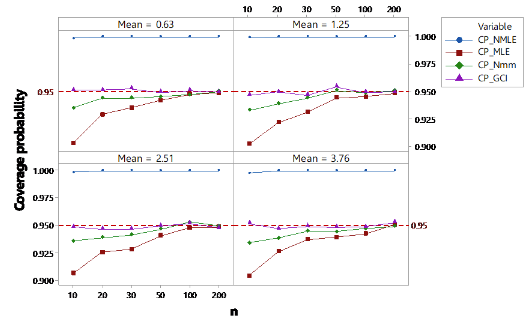Confidence Interval for the Population Mean of Rayleigh Distribution with Application to Shear wave Velocity of Soils in Thailand
Keywords:
Interval Estimation, Continuous Distribution, Coverage probability, Generalized Confidence IntervalAbstract
Rayleigh distribution is one of continuous probability distributions applied in several areas, especially in engineering and medicine. This probability model is also widely occurred in natural phenomenon. Since Rayleigh distribution is related to qualitative data, we are interested in studying interval estimation for the population mean. The two methods based on Wald-type and generalized confidence intervals are used in construction. Then, the performance of the proposed confidence intervals is conducted using simulations in terms of coverage probability and expected length. The results illustrate that the novel generalized confidence interval performs better than the compared confidence intervals in all cases in the study. Finally, a real data set on the shear wave velocity of soils in Lamphun province of Thailand is used in computation, in order to confirm the results from simulation.
References
Ahmed, A. A., Ahmad, S. P.,& Reshi, J. A. (2013). Bayesian analysis of Rayleigh distribution. International Journal of Scientific and Research Publications, 3(10), 1-9.
Ahn, C. Y., Jung, Y. M., Kwon, O. I., & Seo, J. K. (2012). Fast segmentation of ultrasound images using robust Rayleigh distribution decomposition. Pattern Recognition, 45(9), 3490-3500.
Ateeq, K. Qasim, T. B.,& Alvi, A. R. (2019). An extension of Rayleigh distribution and applications. Cogent Mathematics & Statistics, 6(1622191), 1-16.
Casella, G.,& Berger, R. L. (2002). Statistical Inference. California, USA: Duxbury Press.
Dey, S. (2009). Comparison of Bayes estimators of the parameter and reliability function for Rayleigh distribution under different loss functions. Malaysian Journal of Mathematical Sciences, 3(2), 249-266.
Dey, S., & Dey, T. (2014). Statistical inference for the Rayleigh distribution under progressively type-II censoring with binomial removal. Applied Mathematical Modelling, 38(3), 974-982.
Abd Elfattah, A. M., Hassan, A. S., & Ziedan, D. M. (2006). Efficiency of maximum likelihood estimators under different censored sampling schemes for Rayleigh distribution.Interstat,1, 1-16.
Islam, D. K., Chaichana, T., Dussadee, N., & Intaniwet, A. (2017). Statistical distribution and energy estimation of the wind speed at Saint Martin’s Island, Bangladesh. International Journal of Renewable Energy, 15(1), 77-88.
Kruiver, P. P., Dedem, E. V., Romijn, R., Lange, G. D., Korff, M., Stafleu, J., Gunnink, J. L., Marek, A. R., Bommer, J. J., Elk, J. A., & Doornhof, D. (2017). An integrated shear-wave velocity model for the Groningen gas field, The Netherlands. Bulletin of Earthquake Engineering, 15(9), 3555-3580.
Liebenberg, S. C., & Allison, S. J. (2023). A review of goodness-of-fit tests for the Rayleigh distribution. Austrian Journal of Statistics, 1-22.
Nar, F., Okman, O. E., Özgür, A., & Çetin, M. (2018). Fast target detection in radar images using Rayleigh mixtures and summed area tables. Digital Signal Processing, 77(2018), 86-101.
Pasari, S., & Dikshit, O. (2015). Earthquake interevent time distribution in Kachchh, Northwestern India. Earth, Planets and Space, 67(1),1-17.
Pishgar-Komleh, S. H., Keyhani, A., & Sefeedpari, P. (2015). Wind speed and power density analysis based on Weibull and Rayleigh distributions (a case study: Firouzkooh county of Iran). Renewable and Sustainable Energy Reviews, 42, 313-322.
R Core Team. (2023). R: A Language and Environment for Statistical Computing. Vienna, Austria.
Sarti, A., Corsi, C., Mazzini, E., & Lamberti, C. (2005). Maximum likelihood segmentation of ultrasound images with Rayleigh distribution. IEEE Transactions on Ultrasonics, Ferroelectrics, and Frequency Control, 52(6), 947-960.
Seo, J. I., Jeon, J. W., & Kang, S. B. (2016). Exact interval inference for the two-parameter Rayleigh distribution based on the upper record values. Journal of Probability and Statistics, 2016, 1-5.
Weerahandi, S. (1993). Generalized confidence intervals. Journal of the American Statistical Association, 88(423), 899-905.
Wolodzko, T. (2020). Additional Univariate and Multivariate Distributions. https://cran.r-project.org/web/packages/extraDistr/extraDistr.pdf
Xu, W., Ning, L., & Luo, Y. (2020). Wind speed forecast based on post-processing of numerical weather predictions using a gradient boosting decision tree algorithm. Atmosphere, 11(7). 1-38.
Nungnun, C., Phungkham, N., Srikongruk, S., Mameechai, D., Thongperm, P., & Noolek, W. (2561). Trends in earthquakes in Thailand and Burma. Journal of Thaksin University, 21(3), 168-173.(in Thai)
Thitimakorn, T., Luang-Sunthornkul, N., Junthamas, P., & Hansiri, A. (2551). Determining the shear wave velocity of the Bangkok soil layer From surface wave analysis. Substance Engineering, Research and Development Edition, 19(4), 30-35.(in Thai)
Raenak, T. (2557). Determination of soil shear wave velocity using an MASW surface wave receiver belt. Mueang District area Lamphun Province[Unpublished Bachelor thesis]. Chulalongkorn University.(in Thai)

Downloads
Published
License
Copyright (c) 2023 Journal of Applied Science and Emerging Technology

This work is licensed under a Creative Commons Attribution-NonCommercial-NoDerivatives 4.0 International License.

